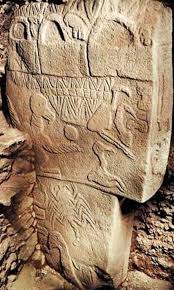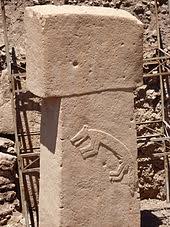 What is Gobekli Tepe? In the Southeastern Anatolia Region of Turkey, close to the traditional Garden of Eden, rests Potbelly Hill. Within the hill lies an ancient temple that is 10-13,000 years older than Stonehenge or the pyramids of Egypt. Everything archaeologists know about civilization is being rewritten because the temple shows an organization, a building acumen and artistic expression not known at the time of hunter-gatherer tribes. Gobekli Tepe's secrets have been well-hidden beneath mounds of mud and debris. Numerous animal skeletons have been unearthed leading researchers to believe the temple was used for animal sacrifice. It is thought a comet impact that took place around that time might account for the burial and the destruction of that particular civilization because no trace of them remains.The people of the temple were far more advanced than the surrounding neolithic tribes and who and what they were as a civilization remains a mystery. Building the temple For now, the builders and planners are unknown, but what has been discovered is that they possessed an intellect that grasped the possibility of an afterlife and reveled in artistic expression that rivals today's religious institutions. Hunter-gathers were thought to be shamanistic, but these people had left shamans behind and had shifted into a more organized religious structure. The builders On site, T-shaped pillars weigh 40-60 tonnes each and the pillars run from 3 to 6 meters high. Specialized equipment would be needed to move stones that size without breaking them. Not only that, but Gobekli Tepe was not a first attempt. The people who created the temple knew exactly how to place the supports needed to sustain the building. An ancient architect directed the workers on the placement of the pillars and whomever she or he was, they knew exactly where each stone went. The artists Amazing near perfect renderings of bulls, foxes and cranes leap from the stone while relief sculptures of crocodile, wild boar, lions, foes, gazelles and more ride piggy-back on megalithic stone structures. The artists were extremely sophisticated and must have had years of experience. The temple predates the Neolithic Revolution, ceramic pottery, metallurgy, as well as the invention of writing and the wheel. It is the oldest site known to #archaeology. The theories Gobekli Tepe is thought to be a burial site though no one has discovered any plots. It is possible the graves lie beneath the structure. It is their best estimation that the site's primary functions were ritual burials in addition to being a social gathering place, but as of now, no one really knows for sure. The site was discovered by Savak Yildiz, a shepherd in 1994 though it is thought this may have been a discovery rediscovered. Of course there are others who believe the site to be home to the Anunnaki, the off worlders living on the planet Nibiru. But that is a story for another time. The timeline Current belief is that in 10 to 13,000 BC, agricultural and neolithic settlements were just beginning to spread. World population was stable with most living in small hunter-gatherer groups. It was the first time gold and silver was used for ornaments which is why the temple stands out so clearly. As far as anyone knows, no known civilization or group has shown sign of being able to duplicate what has happened at Gobekli Tepe. Join the fun Check out my Facebook friends and discover what era they would have preferred to live in. Would you like to be a part of my Facebook family? Click here to friend me and make your opinion known. #GobekliTepe #archaeology #mysteries #paranormal Comments are closed.
|
Sign up today for freebies and fun. Grab your chance at signed copies of my paperbacks and free e-books.
For Kobo coupons click here or copy and paste the link into your browser.
http://www.therawfeed.com/stores/kobobooks-com |
Proudly powered by Weebly





 RSS Feed
RSS Feed

